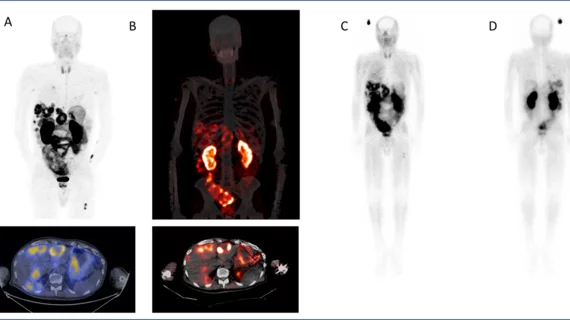SNMMI unveils Image of the Year
The Society of Nuclear Medicine and Molecular Imaging today unveiled its image of the year—which is actually a group of images displaying the efficacy of a 68Ga-DOTA-5G and 177Lu-DOTA-ABM-5G theranostic pairing that improves the detection and treatment of metastatic pancreatic cancer.
The 2023 SNMMI Henry N. Wagner Jr. Image(s) of the Year include PET/CT, SPECT/CT and whole-body planar images showing the results of the theranostic pairing post-injection and treatment. The images came from the first-in-human study that tested the pairing in pancreatic adenocarcinoma—a cancer experts involved in the study described as “lethal” due to its aggressive nature and historically poor outcomes.
“Poor patient outcomes are due partly to the late stage at which the majority of patients are diagnosed and partly to the limited and relatively ineffective treatment options,” explained Julie L. Sutcliffe, PhD, director of the Cyclotron and Radiochemistry Facility in the Center for Molecular and Genomic Imaging and co-director of the Center for Molecular and Genomic Imaging at the University of California–Davis. “Our goal with this study was to develop a theranostic strategy to facilitate both earlier detection and more effective treatment for this devastating malignancy.”
For their research, experts sought to target integrin αvβ6, which is an epithelial-specific cell surface receptor that is up-regulated in epithelial cell cancers, including pancreatic cancer. The research team radiolabeled αvβ6-integrin-targeted peptides to create the 68Ga-DOTA-5G / 177Lu-DOTA-ABM-5G pair.
The group had patients with metastatic or locally advanced pancreatic cancer undergo 68Ga-DOTA-5G PET/CT scans, followed by vitals, blood work and EKG one and seven days after completing their imaging. Lesions with an SUVmax more than two times the normal lung or liver uptake qualified patients for 177Lu-DOTA-ABM-5G treatment, after which they underwent whole-body planar imaging and SPECT/CT exams (again, one and seven days later).
Of the 17 patients who completed 68Ga-DOTA-5G PET/CT, 14 underwent subsequent treatment. The imaging agent detected bone, lung and hepatic metastatic lesions, which were shown to retain 177Lu-DOTA-ABM-5G. Thus far, the pairing has proven itself safe and there have been no reports of drug-related serious adverse events in any of the patients, marking a "major improvement" in comparison to current metastatic pancreatic cancer treatments, Sutcliffe noted.
“This approach has the potential to significantly improve the clinical care and treatment for patients with metastatic disease," Sutcliffe said.
Additional trials testing the pairing are set to begin later in 2023.

